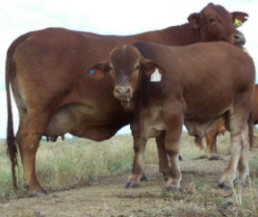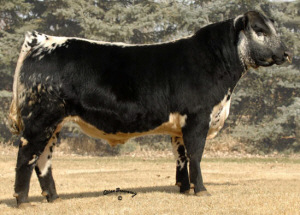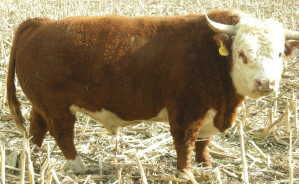



Droughtmaster
History
Droughtmaster was the name originally coined by a group of astute cattlemen in North Queensland for the breed of cattle which they developed through crossing Bos taurus and Bos indicus breeds to overcome the perennial problems of drought, cattle ticks, heat, eye cancer and many other problems that reduced production and profitability.
With the arrival of cattle ticks into North Queensland in 1896, it became apparent that maintaining herds of British breed cattle (such as Shorthorns, Herefords and Shorthorn-Devon cross) in the harsh tropical environment was virtually impossible. Consequently, graziers began experimenting with crossbreeding.
In 1910 three Zebu bulls (the first Bos indicus cattle imported into the area) from the Melbourne Zoo were made available to grazier friends in the north by the Curator of the Melbourne Zoological Gardens.
 Photo courtesy of Red Hill Droughtmaster Stud, www.redhillstud.com.au |
In 1926 a northern grazier, Mr R L (Monty) Atkinson saw several descendants of the Melbourne bulls, and despite the region experiencing severe drought conditions at the time, all the Zebu-British cross cattle were in good condition.
He was so impressed by the descendants of the Zebu bulls from Melbourne, that he set about attempting to develop a breed which had the attributes required to withstand the severe environment of the tropics (from the Zebu), but in the right proportions to retain the benefits offered by the British breeds (Bos taurus).
A consignment of Brahman cattle was imported into Queensland in the early 1930's and Monty Atkinson was given access to three red half-bred Brahman bulls, which through the following years he joined to Shorthorn and Shorthorn-Devon cross females.
The best quarter-bred progeny were selected for retention in the breeding herd. This process was carefully carried on over the years in a 'grading-up' program.
During the 1940's Mr Robert Rea of 'Kirknie', Home Hill, also commenced developing a herd suitable for the Queensland environment. The Kirknie herd was started with a red half-bred Brahman bull from St. Lawrence, followed by a purebred Brahman from 'Wetherby Stud', Mt Molloy. Another cattleman who had a profound effect on the Droughtmaster breed was Mr Louis Fischer of 'Daintree' north of Cooktown.
The pioneer breeders, through careful culling and selection of progeny from the crossing of Bos indicus and Bos taurus genetics, created the Droughtmaster breed, an adaptable, fertile and easy-care breed.
Characteristics
The Droughtmaster is a medium sized breed, tan to red in colour. It has a short sleek coat with loose skin to enable it to lose heat in the sun.
The cows have a range of qualities such as calving ease with Bos indicus pelvic structure traits and low weight calves, strong maternal instincts, high milk production and the females mature early - some in calf at 14 months.
The bulls are docile, virile and mature early making a longer working life possible. The important breed characteristics of low birth weights and calf shape are passed on by Droughtmaster bulls, and can be very advantageous in crossbreeding or joining to heifers.
 Photo courtesy of Angle Zed Droughtmasters, www.anglezed.com |
Statistics
Comparative
Optimum growth under a range of variable conditions is major benifit offered by the Droughtmaster. From prime improved pastre in temperate regions, light native pasture in troical right through to drought conditions which invariably plague many areas of Australia, the Droughtmaster is recognised as one of the leading performers. Improved Pastures (Buffel)
Douglas Daley Reasearch Station N.T. .84 kg/day
(through 5 month wet season)
Native Pastures
Kidman Springs Reasearch Station N.T. .36 kg/day
(average p.a. 1997-2002)
Asian feedlots are an important and growing section of theh global beef production chain. Access to high quality stock feed as well as climatic extremes are major challenges for them. An ability to handle the Asian heat and humidity, complemented by the efficient conversion of lower quality feed make the droughtmaster a popular choice for the Asian feedlot buyers. This growth performance is highlighted in the following figures recorded for Droughtmaster steers & heifers in an indonesian feedlot.
Steers Shortfed (41 days) 1.92 kg/day
Steers Shortfed (90 days) 1.45 kg/day
Heifers Shortfed (48 days) 1.65 kg/day
Heifers Shortfed (80 days) 1.27 kg/day
Data supplied by Austasia PTY LTD
Distribution
The Droughtmaster is produced in Australia and Asia.
References (the above information was cited from the following sites)
www.droughtmaster.com.au
www.redhillstud.com.au
www.anglezed.com


